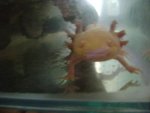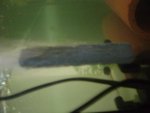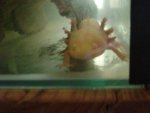Thank you for your reply, Ray, but I'm still not coming up with any possible reasons for the loss of her gill fimbraie.
The water temperature is fine, the Ph, nitrates, nitrites, and ammonia levels are just where they should be, the axolotl has a very healthy appetite and shows no signs of illness or parasites, I have no fish or other animals in the tank with the two axies (and as I said, they are separated, so we know that the black one isn't nibbling on the white one), and my tank IS aerated, but just so slightly. I have a sponge filter attached to an air pump, and I have an air pump regulator attached, which I've adjusted so that the air flow is really minimal.
If it were an issue with the air flow, then the black axolotl would probably be showing signs of gill loss as well, right? In fact, any issues of any kind would (and should) theoretically be affecting BOTH axolotls if they're together in the same tank! Yes, it's possible that the white one could be more susceptible to a negative tank environment than the black one is, but you would think that with such extreme gill loss on the white one, the black one would be showing SOME signs of illness as well.
As I said, I've had the white axie for about two years. She was in such bad shape when I received her, with her limbs bitten off and those small gills, that I was worried that she wouldn't make it. She actually turned out to be very hearty! Her gills looked like that when I got her, and about 5-6 months later, they started showing some signs of improvement, but now, it looks like they've regressed back to their old, shabby state. I am completely confused by all of this.
Thanks again for your help, but is there anything else you can think of?




